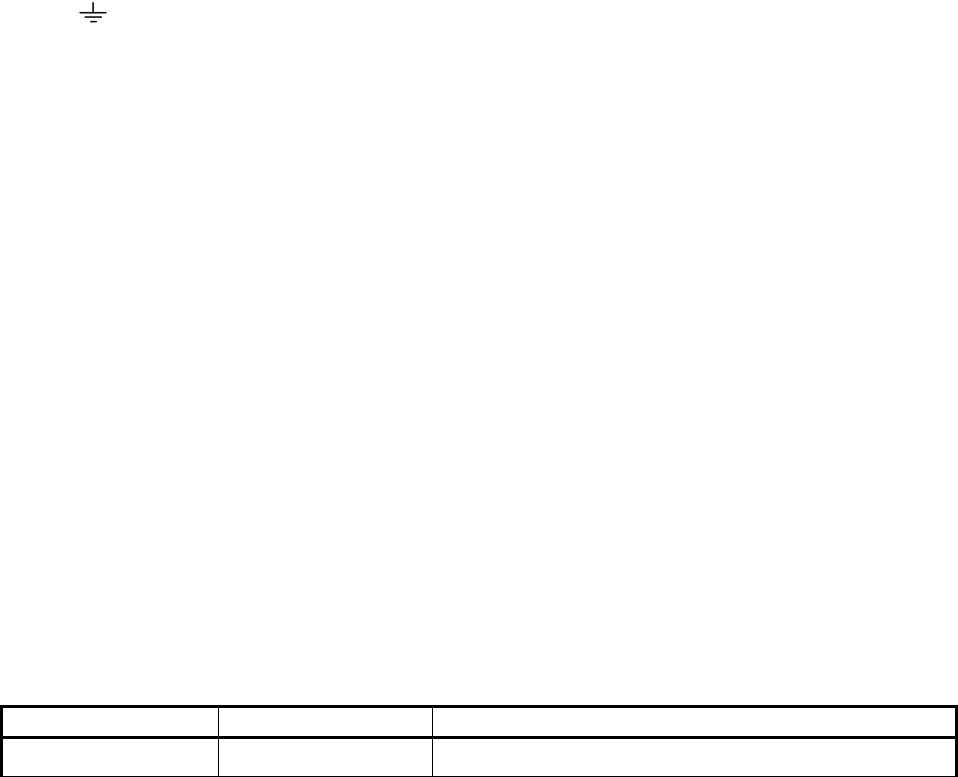
4
CONNECTION OF THE APPLIANCE TO THE ELECTRICITY SUPPLY:
Connection to the electricity supply must be carried out according to the norms and indications of the law in force.
Before carrying out the connection check that:
- The electric charge of the system and the sockets are suitable for the maximum power of the appliance ( see label on the lower part of
the case ).
- The socket or system is equipped with an efficient earth connection according to the norms and indications of the law currently in force.
No responsibility can be held if these indications are not respected.
When the connection to the electricity supply is made with a socket.
Fit onto the electric cable a standard plug ( if it is not provided ) which is appropriate for the charge indicated on the label. Connect up
the wires according to the diagram in Fig. 10 taking care to respect the corresponding pairs listed below:
letter L (phase) = brown coloured wire;
letter N (neutral) = blue coloured wire;
symbol”
” earth = green-yellow coloured wire;
- The electric cable must be positioned so that it cannot reach a temperature of over 75 K at any point.
- Do not use reducers, adapters or shunts for the connection as they could cause false contacts and subsequent dangerous
overheating.
When the connection is made directly with the electricity supply:
- Make sure that there is a device to disconnect the appliance from the mains with a contact opening distance sufficient for complete
disconnection in category III overvoltage conditions.
- Place a single-pole switch between the appliance and the electricity supply. The switch must be of a suitable charge for the appliance
with a minimum opening between the contacts of 3 mm.
- Remember that the earth wire must not be interrupted by the switch.
- Alternatively the electrical connection can also be protected by a differential switch of high sensitivity.
- You are strongly advised to fix the special yellow-green earth wire to an efficient earthing system
ATTENTION:
The appliance conforms to the EEC indication 90/396 regarding gas cooking appliances for domestic use.
All our appliances are designed and produced according to the European norms EN 60 335-1 and EN 60 335-2-6 and additional
relative amendments. The appliances conform with the indications of the European Low Tension Directive 73/23 and 93/68 as
well as conforming with the indications of the European directive 89/336 regarding electromagnetic compatibility.
MAINTENANCE OF THE MACHINE
CHANGING THE PARTS
Before carrying out any maintenance work, disconnect the appliance from the gas and electric supply.
To replace different components such as burners, taps and electrical parts you must take out the hob from the kitchen unit by releasing
the fixing hooks, unscrew the fixing screws of the burners on the work top, unscrew the fixing nuts of the electric plates which are visible
on the lower part of the hob and remove the worktop in order to carry out the replacement of the defective parts.
NOTE: If the taps need replacing you also need to unscrew the two fixing screws of the gas ramp at the bottom of the hob which are
found on the upper part of the latter.
For appliances equipped with automatic “ON” switches you must dismantle the “ON” switch chain before replacing the taps.
You are advised to change the seal on the tap every time you replace a tap in order to ensure a perfect hold between the body and
ramp.
WARNING: The electric cable which is provided with the appliance is connected to the appliance with a type X connection (in
accordance with the norms EN 60335-1, EN 60335-2-6 and successive variations) and thus can be replaced with the same type of cable
as that installed without using special tools.
In the event of wear or damage to the mains cable, replace it following the indications shown below in table n°3:
TABLE N° 3: Types and sections of the electric mains cable for hobs
Dimensions of hob Type of hob Type/ section of mains cable
59 x 50 cm.
86 x 50 cm.
gas burners H05RR-F 3x0,75 mm2
WARNING: If you replace the electric mains cable the installer must have the earth conductor about 2 cm longer than the phase
conductors and must also take heed of the warnings regarding electric connection.
Oiling the taps: (This must be carried out by qualified staff from a technical assistance centre)
If a tap becomes difficult to move you must oil the tap, without delay, following the instructions given below:
1) Dismantle the main part of the tap by unscrewing the two screws that can be found on the bar of the tap itself. (Fig. 11)
2) Take out and clean the holding cone and its setting with a cloth soaked in diluent.
3) Oil the cone lightly with the special oil.
4) Insert the cone, move it a few times, take it out again, remove the excess oil and make sure that the areas where the gas flows are
not obstructed.
5) Reassemble all the pieces in the reverse order to that followed for the dismantling and check that the tap is working properly.


















